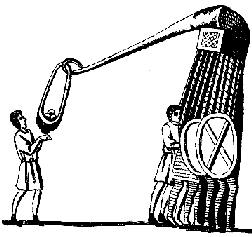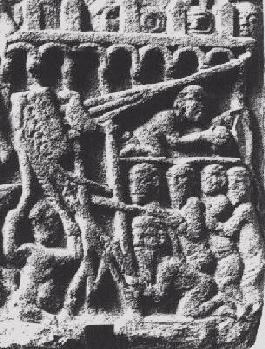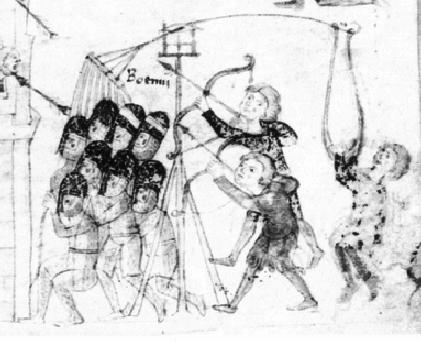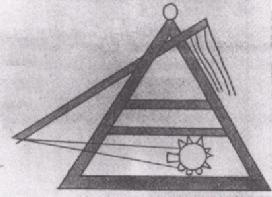
|
Part 1 |

|
Part 1 |
|
This is one of a series of pages of
Medieval and Renaissance illustrations of traction trebuchets. To avoid
problems with historical interpretation (& copyright!) as much as
possible, I have chosen to use pictures which seem to be plausibly
contemporary with the devices being illustrated. Where ever possible
the original source is cited. I have also tried to avoid what seem to
be obvious fantasy pieces. . |
| No. 1 - The Siege of Carcassonne |

Simon was killed during another siege during the crusade against the Cathars and it is usually said that he died from a blow to the head from a traction trebuchet stone cast by the townswomen of Toulouse in 1218.
| No. 2 - Chronicle of Petrus de Eboli |

Both
machines are of single post construction: the axle is supported between
two uprights, but these are joined and mounted on top of a single pole
(which is solidly braced).
Presumably, this arrangement could allow the trebuchet to be rotated and so facilitate aiming.

Here is another view of the scene, this time a close up of the attackers and their machine.
The shape of the axle is clear here - thickest in the middle and tapered in a curve to the end bearing surfaces.
Also clear is the typical European trebuchet's arrangement of the two
sling cords that hold the pouch.. one fixed to the beam a little way
from the end, the other hanging by a loop over a hook (even if this
hook is a bit over-exuberantly curved and unlikely to ever release the
cord loop).
Many illustrations, like this one, show a loader holding the sling -
even during the actual launch. It has been suggested that this would
give more power by "twanging" the beam, and this illustration shows a
bent beam.
Grey Co's experiments also suggest that it helps synchronise the pullers' efforts.
W.T.S. Tarver's experiments at the University of Toronto in 1991 found
that this practice did improve the machine's performance. His team also
demonstrated the way the slingman could alter the stone's flight by
holding the sling pouch at different starting angles in accordance with
Arab writings. (More of Tarver's experiments - with kind permission -
soon)
| No. 3 - Hasan al-Rammah |

Traction Trebuchet from Hasan al-Rammah c.1285
This
drawing shows something very unusual - a traction trebuchet apparently
fitted with a launch trough and using the tucked-under starting
position for the sling normally only seen on counter-weight machines.
Such a "halfway" machine's existence makes sense, but is not seen elsewhere.
The geometry of the machine in this drawing is also interesting... the
beam appears to be suspended below the apex of an A-frame. This is
probably workable as a traction trebuchet.
However, the sling cords are shown passing on the opposite side of the
frame - giving it a look more in keeping with decorative geometric
knotwork than a technical drawing of a weapon.
The "ring" at the top of the frame is another mystery.
Finally, the projectile is certainly not a smooth round stone. It
appears to have a neck - like a pot - and is drawn covered with
"spikes". A first guess would be that it's an incendiary "bomb",
perhaps containing inflammable liquid such as Greek Fire or Naft. The
spikes may be real, or may simply represent flames.
| - NAVIGATION -
|
||||
|---|---|---|---|---|
 |
||||
 |
Previous | Next |  |
|
| Page |
|
Page | ||
 |
|---|